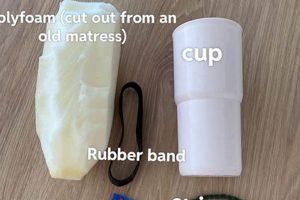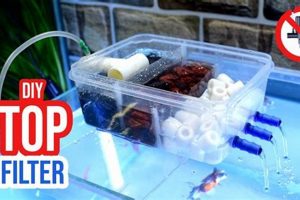Small, personalized adornments for keys created through individual effort are gaining considerable traction. These handcrafted items serve not only a functional purpose but also as expressions of personal creativity and style. They range from simple designs using readily available materials to more complex projects incorporating advanced crafting techniques. For example, a simple design might use beads and string, while a more complex project might involve resin casting or intricate metalwork.
The appeal of creating personalized key accessories stems from several factors. Individuals can tailor the item to their specific tastes, hobbies, or affiliations, fostering a sense of ownership and connection. The creation process offers a productive and engaging hobby, potentially reducing stress and enhancing fine motor skills. Historically, crafting small personal items has served as a means of self-expression and resourcefulness, a tradition that continues to resonate with modern practitioners.
The following sections will delve into various aspects of crafting these personalized key accessories. These include exploring different material options, examining essential tools and techniques, and providing inspirational ideas for diverse designs. Furthermore, safety considerations for each stage of the crafting process will be addressed.
Crafting Personalized Key Adornments
Achieving successful and visually appealing personalized key accessories requires careful planning and execution. The following tips provide guidance on key aspects of the design and creation process.
Tip 1: Material Selection is Paramount: Choose materials that align with the intended design aesthetic and offer appropriate durability. For leather-based projects, select high-quality leather with suitable thickness. For resin-based options, opt for UV-resistant resins to prevent yellowing over time.
Tip 2: Prioritize Design Planning: Before commencing the crafting process, create a detailed sketch or digital rendering of the intended design. This blueprint should include precise measurements, material specifications, and color palettes. This pre-planning minimizes errors and wasted materials.
Tip 3: Ensure Accurate Measurements and Cutting: Precise measurements are crucial for achieving a professional finish. Use a reliable measuring tool and sharp cutting implements to ensure clean and accurate cuts. Inaccurate cuts can compromise the overall structural integrity and visual appeal.
Tip 4: Invest in Quality Tools: Employing appropriate tools is essential for effective and safe crafting. For example, when working with metal, utilize appropriate soldering or welding equipment. When working with leather, leverage specialized leatherworking tools for cutting, punching, and stitching.
Tip 5: Employ Secure Attachment Methods: The method used to attach the charm to the keyring is paramount for functionality. Utilize robust attachment hardware such as split rings or swivel clasps. Ensure that all connections are securely fastened to prevent accidental detachment and loss.
Tip 6: Address Edges for a Polished Look: Pay meticulous attention to the edges of the crafted item. Edges can be treated using various techniques, such as sanding, burnishing, or painting, to create a smooth and professional finish. This detail significantly enhances the overall aesthetic.
Tip 7: Consider Functionality and Weight: While aesthetics are important, functionality should not be overlooked. Avoid creating overly bulky or heavy designs that may be cumbersome to carry. A balanced design prioritizes both visual appeal and practical usability.
By adhering to these guidelines, craftspeople can significantly improve the quality, durability, and aesthetic appeal of individually designed key accessories. Careful planning, material selection, and execution are essential for achieving professional-level results.
The subsequent sections will provide further detail on specific crafting techniques and design inspiration to facilitate the creation of unique and personalized key adornments.
1. Material Properties
Material properties are a crucial determinant in the quality, longevity, and aesthetic of handcrafted key accessories. The inherent characteristics of chosen materials dictate their suitability for specific designs and their capacity to withstand daily wear and tear.
- Durability and Tensile Strength
The ability of a material to resist wear, abrasion, and breakage under stress is paramount. For keychains intended for daily use, materials with high tensile strength, such as stainless steel or thick leather, are preferable. Inadequate tensile strength may lead to breakage, compromising both functionality and aesthetics. Example: Polymer clay, while versatile, may be prone to cracking if not properly cured, rendering it unsuitable for high-stress applications.
- Resistance to Environmental Factors
Keychains are exposed to a variety of environmental conditions, including moisture, sunlight, and temperature fluctuations. Materials that are resistant to corrosion, fading, and warping are essential for maintaining the item’s appearance and structural integrity. Example: Unprotected metals may rust when exposed to humidity, while certain plastics may degrade under prolonged UV exposure. Resin with a UV stabilizer helps prevent the keychains yellowing over time.
- Workability and Formability
The ease with which a material can be shaped, cut, and joined is a significant factor in the crafting process. Materials that are easily worked with, such as soft metals or pliable fabrics, allow for greater design flexibility and reduce the likelihood of errors. Conversely, materials that are difficult to manipulate may require specialized tools and techniques. Example: Thin gauge wire is easily manipulated for intricate designs, whereas thick gauge wire requires more force and specialized tools.
- Aesthetic Characteristics
The visual and tactile properties of a material contribute significantly to the overall aesthetic appeal. Factors such as color, texture, and sheen can influence the perceived value and desirability of the finished product. Example: Natural materials like wood or gemstones offer unique textures and patterns, whereas synthetic materials can provide a consistent and uniform appearance.
The careful consideration of these material properties is essential for creating key accessories that are both visually appealing and functionally durable. The informed selection of materials based on their inherent characteristics ensures that the finished product meets the intended design specifications and withstands the rigors of daily use. Ultimately, understanding material properties allows craftspeople to make informed choices that enhance the quality and longevity of their creations.
2. Design Complexity
Design complexity, in the context of handcrafted key accessories, directly influences project feasibility, time investment, and required skill level. It represents the intricacy of the planned aesthetic, the number of components involved, and the techniques employed during creation. A complex design demands greater precision and may necessitate specialized tools or materials.
- Number of Discrete Components
The quantity of individual parts comprising the finished item significantly impacts complexity. A simple design may consist of a single piece of molded resin, while a complex design could incorporate multiple beads, metal findings, and intricate knotwork. Increasing the component count escalates the assembly time and demands precise alignment and secure fastening. Example: A beaded keychain with multiple rows of individually strung beads increases complexity relative to a single-charm design.
- Intricacy of Geometric Forms
Designs involving complex geometric shapes or asymmetrical patterns inherently require greater skill and precision. Replicating intricate designs consistently can be challenging, demanding precise measurements and meticulous execution. Such designs may necessitate the use of templates or advanced crafting techniques. Example: Creating a keychain with a Celtic knot design is more complex than forming a simple geometric shape like a circle or square.
- Varied Material Integration
Combining diverse materials with differing properties presents a unique set of challenges. Each material may require specific adhesives or joining techniques, and their compatibility must be carefully considered to ensure structural integrity and aesthetic harmony. Integrating dissimilar materials increases the skill requirements for a successful project. Example: A keychain combining leather, metal, and glass elements requires expertise in working with each material and effectively joining them.
- Level of Embellishment and Detail
The extent of surface ornamentation, such as engraving, painting, or beadwork, contributes significantly to design complexity. Intricate embellishments demand meticulous attention to detail and specialized tools, such as fine-tipped brushes or engraving implements. Achieving a professional finish on highly embellished designs requires considerable skill and patience. Example: A keychain with hand-painted miniature artwork is more complex than one with a simple, solid-color finish.
The interplay between these facets of design complexity directly affects the accessibility and enjoyment of individually designed key accessories as a creative endeavor. While simple designs offer a low barrier to entry for beginners, complex designs provide opportunities for experienced craftspeople to challenge their skills and create truly unique and personalized items. The choice of design complexity should align with the crafter’s experience level and available resources, ensuring a rewarding and achievable crafting experience.
3. Attachment Security
Attachment security represents a critical yet often overlooked aspect of personalized key accessories. A weak or improperly secured attachment mechanism directly results in the loss of keys or the charm itself, negating the keychain’s functional and aesthetic value. The selection and implementation of robust attachment methods constitute an essential component of the crafting process, impacting user satisfaction and the overall utility of the finished item. For instance, a keychain constructed with high-quality materials and an intricate design becomes essentially useless if the attachment point fails, leading to a frustrating and potentially costly situation for the user. A common example involves the use of flimsy jump rings, which can easily separate under minimal stress, causing the charm to detach from the keyring.
Different designs and materials necessitate varying attachment approaches. For keychains incorporating heavy pendants, reinforced split rings or swivel clasps offer increased durability and resistance to accidental opening. Leather keychains may benefit from riveted or stitched attachment points, distributing stress more evenly across the material. Metal keychains often rely on soldered or welded connections to ensure a permanent and secure bond. In practice, a crafter creating a macrame keychain should carefully integrate the keyring attachment point into the knotting structure, using a durable cord and secure knots to prevent separation. Similarly, a resin keychain should have the keyring bail cast directly into the resin, rather than simply glued on, to ensure a strong and lasting connection.
In summary, attachment security is not merely a detail but a fundamental requirement for successful key accessories. Ignoring this aspect undermines the entire crafting endeavor. By prioritizing robust attachment methods and carefully considering the materials and design, craftspeople can significantly enhance the usability, longevity, and value of their creations, ensuring that the personalized key accessories remain both aesthetically pleasing and functionally reliable. Over-engineering the attachment is often preferable to risking failure, given the inconvenience and potential loss associated with a weak connection.
4. Finishing Techniques
The application of finishing techniques is paramount to elevate handcrafted key accessories from simple projects to refined, durable items. These techniques encompass a range of processes applied after the primary construction phase, aiming to enhance aesthetic appeal, improve material longevity, and ensure user safety. The effectiveness of chosen finishing methods directly impacts the perceived value and overall quality of personalized key adornments.
- Edge Treatment
The treatment of edges, particularly on leather or polymer clay keychains, significantly affects both aesthetics and durability. Techniques such as burnishing, sanding, or painting create smooth, professional-looking edges, preventing fraying or chipping that can compromise the item’s structural integrity. Improperly finished edges can detract from the overall design, even if the primary construction is sound. Example: Raw, unfinished edges on a leather keychain can quickly deteriorate with use, while a burnished edge provides a protective seal and a polished appearance.
- Surface Sealing and Protection
Applying a sealant or protective coating safeguards the keychain against environmental factors like moisture, UV exposure, and abrasion. Sealants are crucial for materials such as wood, painted surfaces, or resin, preventing damage and preserving the vibrancy of colors. The choice of sealant should be appropriate for the material composition to ensure compatibility and optimal protection. Example: A UV-resistant coating on a resin keychain prevents yellowing and fading over time, maintaining the item’s original aesthetic appeal.
- Polishing and Buffing
Polishing and buffing are essential for achieving a high-gloss finish on metal or resin keychains. These techniques remove surface imperfections, enhance the material’s natural luster, and create a smooth, tactile surface. Proper polishing requires specialized tools and compounds, and the process must be performed carefully to avoid scratching o
r damaging the underlying material. Example: Buffing a metal keychain after soldering removes discoloration and creates a professional, mirror-like finish. - Application of Decorative Accents
The addition of decorative accents, such as paint, glitter, or metal leaf, can enhance the visual appeal of keychains, but requires careful execution to avoid a haphazard or unprofessional look. Applying these accents evenly and securely is crucial for maintaining the item’s aesthetic integrity over time. The choice of adhesive or application method should be appropriate for the materials involved. Example: Applying a sealant over glitter on a keychain prevents shedding and protects the glitter from abrasion.
In conclusion, the meticulous application of appropriate finishing techniques is indispensable for creating personalized key accessories that are both aesthetically pleasing and functionally durable. Ignoring these crucial steps can lead to premature deterioration and diminished visual appeal, ultimately detracting from the value and enjoyment of the crafted item. The selection and skillful execution of finishing methods should be considered an integral part of the overall design process.
5. Tool Proficiency
The successful creation of individually designed key accessories hinges significantly upon tool proficiency. The degree of skill and dexterity with various implements directly impacts the quality, precision, and efficiency of the crafting process. Inadequate tool handling can lead to flawed designs, material wastage, and potential safety hazards.
- Cutting and Shaping Instruments
Precise cutting and shaping are fundamental to achieving desired forms. Proficiency with tools such as craft knives, scissors, rotary cutters, and metal shears dictates the accuracy of component dimensions. Inadequate skill can result in uneven edges, misaligned pieces, and structurally weak joints. A leather keychain, for instance, requires sharp cutting tools for clean, defined edges. The use of dull or inappropriate implements may tear or distort the material.
- Adhesive Application and Bonding Tools
Secure and aesthetically pleasing bonding of materials relies on the skillful application of adhesives and the proper use of bonding tools. This includes familiarity with various adhesives, their specific applications, and techniques for controlled dispensing. Examples include epoxy resins, cyanoacrylate adhesives, and specialized glues for fabrics or plastics. Clamps, jigs, and heat guns are often employed to ensure proper alignment and curing. Insufficient expertise can lead to weak bonds, visible adhesive residue, and structural failure over time.
- Drilling and Fastening Equipment
Creating secure attachment points for keyrings or decorative elements often necessitates drilling precise holes and employing appropriate fastening hardware. Proficiency with drills, awls, and riveting tools is crucial for ensuring secure and long-lasting connections. The selection of appropriate drill bit sizes and fastener types directly impacts the structural integrity of the keychain. Improper drilling can result in cracked materials, stripped threads, and a compromised attachment mechanism.
- Finishing and Polishing Implements
Achieving a professional finish requires expertise with various finishing tools and techniques. This includes sanding blocks, polishing cloths, buffing wheels, and specialized compounds. The skillful application of these tools enhances the material’s surface, removes imperfections, and adds a protective layer. Inadequate polishing can leave scratches, dull spots, or an uneven finish, detracting from the overall aesthetic appeal. A metal keychain, for example, benefits from polishing to achieve a smooth, lustrous surface, improving its visual appeal and resistance to corrosion.
In summary, tool proficiency constitutes an indispensable element in the production of high-quality, individually designed key accessories. Mastery of cutting, bonding, drilling, and finishing tools directly translates to enhanced precision, durability, and aesthetic appeal. The investment in acquiring and honing these skills is essential for crafting keychains that are both visually appealing and functionally reliable, underscoring the critical link between expertise and product excellence.
Frequently Asked Questions
This section addresses common inquiries and misconceptions pertaining to the creation of individualized key adornments, providing concise and authoritative responses.
Question 1: What constitutes an appropriate material for creating a durable keychain?
Material selection should prioritize durability and resistance to wear. Suitable materials include stainless steel, high-grade leather, UV-resistant resin, and strong polymers. The chosen material must withstand daily handling and potential environmental exposure.
Question 2: How can detachment of keychains components be prevented?
Secure attachment methods are paramount. Employ robust split rings, swivel clasps, or soldered connections. Ensure all attachments are properly fastened and tested before use. Regular inspection of attachment points is advisable to identify potential weaknesses.
Question 3: What tools are fundamentally necessary for engaging in keychain crafting?
Essential tools vary depending on the chosen material and design. A basic toolkit includes cutting instruments (craft knife, scissors, metal shears), adhesives and bonding agents, drilling and fastening equipment, and finishing implements (sandpaper, polishing cloths).
Question 4: What is the recommended approach to sealing and protecting keychains from environmental damage?
Surface sealing with appropriate protective coatings is recommended, particularly for porous materials such as wood or painted surfaces. Select sealants compatible with the keychain’s material composition to prevent corrosion, fading, and moisture damage.
Question 5: What considerations are essential when working with potentially hazardous materials during keychain construction?
Safety protocols are mandatory when working with potentially hazardous materials such as epoxy resins or sharp tools. Employ appropriate personal protective equipment, including gloves, eye protection, and respirators. Work in a well-ventilated area and adhere strictly to manufacturer’s safety guidelines.
Question 6: How does design complexity impact the overall crafting process of personalized keychains?
Design complexity directly influences project feasibility, time investment, and required skill level. Intricate designs demand greater precision, specialized tools, and potentially increased material costs. Beginners should initiate projects with simpler designs to develop fundamental skills.
The information provided herein serves as a foundational guide for navigating the nuances of personalized key adornment creation. Diligent adherence to these principles will facilitate the production of aesthetically pleasing and functionally robust items.
The following section will provide design inspiration and project ideas to stimulate creativity and expand crafting horizons.
Conclusion
The preceding analysis has detailed various facets of crafting individually designed key accessories. Key areas explored include material selection, design complexity, attachment security, finishing techni
ques, and the necessity of proficient tool handling. These considerations directly impact the durability, aesthetic appeal, and overall functionality of personalized key adornments, collectively informing the creation process.
The effective implementation of these principles promotes the production of durable and visually appealing items. Furthermore, a commitment to safety protocols when handling tools and materials mitigates potential hazards. Continued exploration and innovation within this craft will likely yield advancements in techniques and materials, further expanding creative possibilities. The enduring appeal of personalized key accessories underscores the value of both functional design and individual expression.







